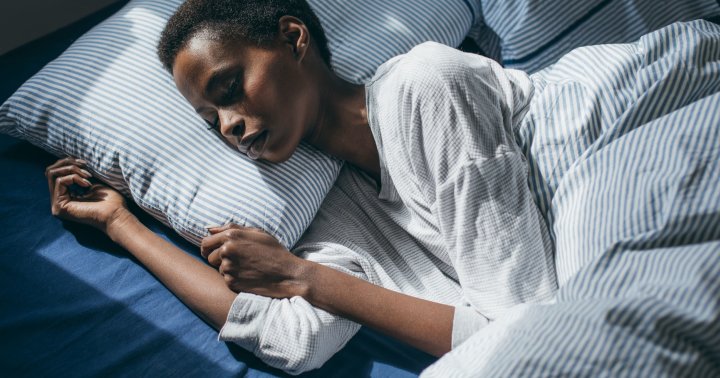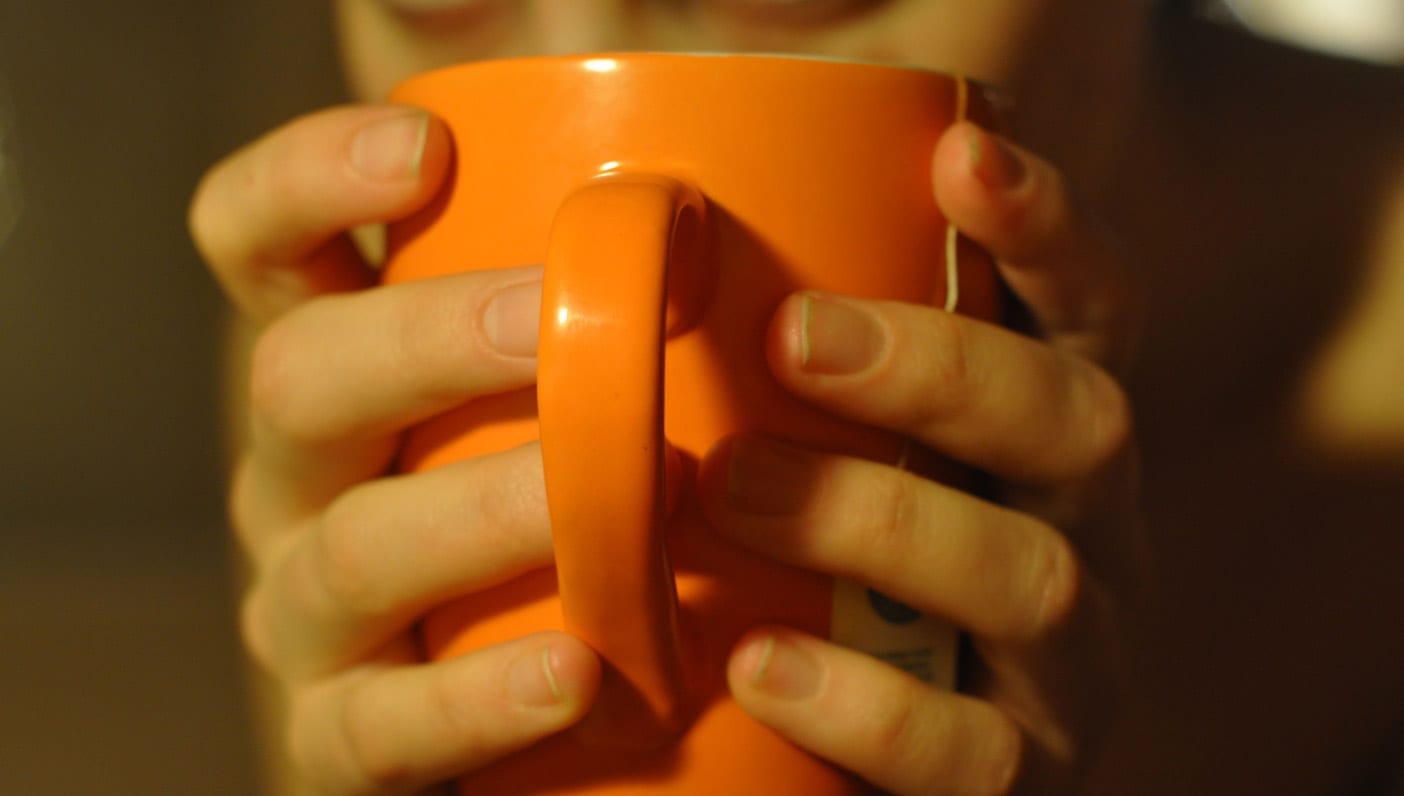Does Your Hair Need A Detox? Here's How To Tell + What To Use
So, what is clarifying shampoo actually clarifying in the first place?


mbg Assistant Beauty Editor
mbg Assistant Beauty Editor
Hannah Frye is the Assistant Beauty Editor at mindbodygreen. She has a B.S. in journalism and a minor in women’s, gender, and queer studies from California Polytechnic State University, San Luis Obispo. Hannah has written across lifestyle sections including health, wellness, sustainability, personal development, and more.
Image by Moyo Studio / istock November 7, 2022 Our editors have independently chosen the products listed on this page. If you purchase something mentioned in this article, we may If you want healthy hair, there’s a long list of possible to-do’s. Limiting the use of hot tools is definitely high up on the list, along with hydrating your strands and, obviously, actually washing your hair every once in a while. And like skin care, some hair care products are certainly optional, but your hair might look and feel a whole lot better with them. Clarifying shampoos are one of those often overlooked but occasionally hair-saving products.
Advertisement
This ad is displayed using third party content and we do not control its accessibility features.
However, these deep cleansers are not to be messed with. Here’s everything, and we mean everything, you need to know about clarifying shampoos. What is a clarifying shampoo?
“A clarifying shampoo is a deep cleanser for the hair and scalp. It is formulated to remove excess buildup from products, impurities, and any residues in the hair and scalp,” stylist, colorist, and co-owner at Broome Street Society in New York City Josie Sanchez tells mbg.
Clarifying shampoos are amped up versions of the day-to-day ones that thoroughly clean both the hair follicles, scalp and hair fiber.
Clarifying shampoo vs. chelating shampoo vs. detox shampoo:
You may hear the names detox shampoo and chelating shampoos too, as they’re all used in generally the same context in casual conversation. While they’re both starkly different from your typical run-of-the-mill shampoo, the true definition of detox shampoo is technically slightly different from clarifying shampoo.
“The main difference lies in the active ingredients in each formula—hair detoxes often rely on natural extracts and oils to remove buildup, while clarifying shampoos typically contain synthetic ingredients such as silicones and sulfates,” certified trichologist, celebrity stylist, and founder of scalp-first hair care brand Act+Acre Helen Reavey tells mbg.
However, when it comes to clean and sustainable beauty, the two are often used interchangeably. To be frank, there are definitely “clarifying shampoos” out there with zero silicones or sulfates, and there are definitely “detox shampoos,” that contain those additives. To sum up, don’t get too caught up in the language.
Advertisement
This ad is displayed using third party content and we do not control its accessibility features.
What do they do and why should you use them?
Clarifying shampoos are stronger than normal shampoos, which is why they have to be used on occasion. Professionals may recommend clarifying shampoos to clients who resonate with specific hair situations. These clients may:
Advertisement
This ad is displayed using third party content and we do not control its accessibility features.
How to use a clarifying shampoo:
Even if you find the best cleansing shampoo on the market, there are a few essential rules the pros want you to follow in order to get the best results with the least amount of complications. These include:
1.
Identify your wash schedule and where it fits in.
Just as you wouldn’t do a detoxifying face mask every time you wash your face, you shouldn’t use a clarifying shampoo every time your strands get wet. According to Sanchez, these are the general guidelines:
If you wash your hair every other day, then you can use a clarifying shampoo every other week. Your strands are likely more oily, so the risk of excessive dryness is fairly low if you follow this schedule.
However for those with dryer hair or a less oily scalp, you probably only wash once or twice a week overall. If that’s the case, then use a clarifying shampoo once a month, maybe twice a month if your strands are craving it—more on that in a bit.
Advertisement
This ad is displayed using third party content and we do not control its accessibility features.
2.
Use a pre-shampoo oil.
If you generally have dry strands, you may want to do an oil treatment (translation: massage a hair oil into your scalp and through your strands) the day before using a clarifying shampoo. This will help your scalp and your strands get a healthy dose of moisture before the deep clean.
That being said, if you’re using a cleansing shampoo more than once a month and realize you have to use an oil before your wash in order to prevent your hair from feeling crispy, then you should dial it back, Reavey says.
3.
Apply to the scalp and massage in with fingers.
Buildup from products like hairspray and dry shampoo can be tacky and hard to kick, even with a strong formula. To make sure you’re getting an efficient clean, use your fingers to work the product into your roots.
Apart from helping you get a deep clean, scalp massage works wonders for the health of your scalp—and research echoes this praise. In fact, in a 2016 study, a small number of men received a daily four-minute scalp massage. At the conclusion of the study, the investigators found an increase in hair thickness1.
A more recent 2019 study found that of the 300 or so participants who followed a specific massage regimen, nearly 70% reported improved hair thickness at the end. If you want to learn more about scalp massage or need a step-by-step tutorial—we’ve got you covered here.
Advertisement
This ad is displayed using third party content and we do not control its accessibility features.
4.
Don’t rub it into your ends.
“I recommend emulsifying the shampoo in your hair and concentrating the product on your scalp and the back of your head,” Reavey says. Try to avoid rubbing it all the way down to the ends of your hair, as the tips are generally the driest part.
“Separate your hair down the middle and work the shampoo into the scalp, letting it rinse throughout the rest of the hair,” she notes. The lengths and tips will naturally get a quick coat of the clarifying shampoo from the runoff, but not more than they need.
5.
Rinse with lukewarm water.
This step is underrated but so important—do not rinse out your hair with steaming hot water. Your scalp is already vulnerable to drying out and hot water will only make it worse. “It is always best to use lukewarm water on your scalp and strands,” Reavey says.
Plus, hot water will dry out the skin on your body and your face anyway, so it’s best to skip the heat altogether.
6.
Follow with a hydrating treatment to seal the cuticles back.
If you’re using a drying cleanser, then you should be compensating with a deeply hydrating conditioner, or better yet, a nourishing hair mask. Look for ingredients like coconut oil, shea butter, hyaluronic acid, and seed oils. If you want to skip the search, here’s 11 mbg approved options to browse.
7.
Rinse with cold water, again.
When you rinse your hair with warm water, your cuticles are more subject to breakage. When you run a cold rinse, though, it helps to seal the cuticles back and better protects your hair. So after your whole wash process is done, crank that shower to a cold temperature for a few seconds before stepping out.
Remember: They can be used intuitively.
Here’s the thing—you don’t have to have a strict schedule when it comes to clarifying washes. If you want to keep a product on hand and use it whenever you feel the need, that’s completely fine, and honestly, a great way to think about it. Just be sure not to use it more than twice a month.
Here’s a few signs you might need a deeper cleanse:
Cautions about using clarifying shampoos.
While clarifying shampoos can be beneficial, they’re not to be used on a whim. These cleansers are powerful, which means they come with a set of guidelines if you want to use them safely. Here’s what the pros want you to know:
They can be very drying, so some hair types can't tolerate them.
“If you have conditions such as excessive dandruff, psoriasis or scalp eczema you should be cautious when using clarifying products, as they can further damage and dry out your scalp,” Reavey says.
Even if you’re experiencing a momentary spout of scalp dryness (this frequently happens when the weather cools down), then you should put your clarifying wash to the side for a bit. Again, you wouldn’t use a detoxifying clay mask on your skin if it’s already too dry or irritated—the same rules apply here.
They shouldn’t be used every wash.
Just to reiterate, “They absolutely should not replace your everyday shampoo, as they strip color and oils,” Reavey says. A quick reminder: If you have dryer hair or wash it once to twice a week, stick to once a month for a deeper clean. If you wash your hair every other day, then using a clarifying wash every other week is ideal. Above all, don’t use a clarifying wash if your scalp or hair already feels dehydrated.
They shouldn’t be used on fresh color.
Important PSA—Do not (we repeat: Do not) use a clarifying shampoo on freshly colored hair. “I would caution those who have recently color-treated their hair to be careful with clarifying shampoos since the product can strip away any color deposit on the hair,” Reavey says.
You’ll want to wait at least two weeks after getting color to use a clarifying shampoo. To be frank, you probably won’t need to use one for a month post-appointment given that your stylist likely gave your scalp a deep cleaning in the salon anyway.
If you have a gloss, then you should limit the use of clarifying shampoos in general, as the color is more susceptible to fading, Sanchez says. All in all, ask your colorist when you’re in the chair when it’s safe to use a clarifying wash.
Can you DIY a clarifying shampoo?
Some people use baking soda and apple cider vinegar as a DIY clarifying shampoo. However, this combination can be stripping for the scalp. This might be tolerable for some, but if you’re prone to dry strands or a dry scalp, it’s best to skip this DIY project.
If you plan on using a clarifying shampoo regularly (once or twice a month) then it is worth investing in a professionally formulated product. You don’t need too much of the product for each wash and with the slow frequency, your product will last you a few months at the very least—AKA, you’ll get a bang for your buck, which makes it all the more worth it.
Clarifying shampoos vs. scalp scrubs.
Clarifying shampoos are hair-focused products, whereas scalp scrubs work on the scalp—obviously. Certified trichologist and hair health expert Shab Reslan breaks this down:
“If your hair feels dull, it's tangling a lot, or you use a lot of styling products daily, you definitely want your clarifying shampoo,” previously told mbg.
If you take a close look at your scalp and see buildup from hair products, or if your hair continuously feels oily even right after you wash it, then you might want to consider a scalp scrub, Reslan says.
If you’re on the hunt for a scalp scrub, look for one with tiny and gentle granules, not large crystals or salts. These will be far too harsh on the scalp and create tears and trigger irritation. Chemical exfoliants like glycolic acid can be beneficial as well.
Do clarifying shampoos affect your scalp microbiome?
Like the skin on your face and body, your scalp skin has a delicate microbiome as well. When there's excessive buildup around the follicle, your scalp can't absorb the nutrients it needs to balance the microbiome and thrive.
Clarifying shampoos can encourage a healthier scalp with proper use by clearing buildup. But, as we said, clarifying shampoos are strong products, and they can throw off the balance of your scalp microbiome if used incorrectly.
Your scalp is full of natural oils that are like food to the microbiome—as in, extremely necessary. So when those oils are fully stripped, that’s when you run into problems.
“When overused, clarifying shampoos can definitely push the scalp microbiome off balance, causing dryness and making the scalp more prone to conditions such as dandruff and irritation,” Reavey warns.
This is why we recommend skipping clarifying cleansers if you do experience excessive dryness, dandruff, irritation, or if you’re prone to scalp eczema or psoriasis. Like many things in beauty, potent products call for strict regimens, and clarifying shampoo is a perfect example of such.
Clarifying shampoos to try:
FAQ
Should you use clarifying shampoo if you have curly hair?
Curly and textured hair tends to be on the dryer side. As said above, those with dry hair can use a clarifying shampoo once a month but shouldn’t exceed that limit—the same goes for curly strands.
What does clarifying shampoo do to bleached hair?
Bleached hair tends to be a bit dryer and more fragile than non-bleached strands. While you can certainly still use a clarifying shampoo on bleached hair every once in a while, it’s best to use it with caution and stick to once a month if you start to feel your hair drying out. If you’re unsure, ask your stylist.
Are clarifying shampoos necessary?
To be frank–not for everyone. You don’t have to use a clarifying shampoo. But if you tend to find buildup on your strands, it’s definitely a good idea. If it’s solely scalp buildup you’re concerned about, then using a product like the Act+Acre Scalp Detox or a gentle scrub is a better idea.
The takeaway.
Clarifying shampoo is not a product to be used without educating yourself how to do so. That being said, the results can be glowing: shiny hair that’s free from buildup and fully reset from whatever you’ve been doing or putting on it as of late. If you’re prepped and ready to dive into your first clarifying shampoo experience, here’s a few more clean options to browse.

 KickT
KickT 

































